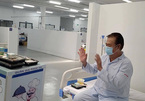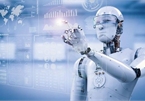 |
|
|
Since early 2021, Do Anh Tuan, the owner of a coffee shop in Hanoi, no longer has to queue to get a number and wait at the offices of banks to make transactions because he can use banking applications on his smartphone or go to the ATM stall in his apartment building for these transactions.
“I am now used to the new technology of Vietnamese banks. This big change will probably cause many banking staff to be jobless,” Tuan said.
According to a report from the State Bank of Vietnam, many banks have achieved over 90% of transaction value on digital channels. Since March 2021, more than 1.8 million payment accounts have been opened under the new eKYC method out of more than 100 million active payment accounts in Vietnam.
A recent survey by consulting firm Mckinsey shows that Vietnamese users are considered to have the fastest acceptance of digital banking and digital payments in the region, up 41 percentage points, reaching 82% in 2021.
In the insurance sector, technology is considered number one in insurance businesses, as virtual assistants are holding an important position. At Vietinbank's insurance company, the chatbot system on its website and facebook page enables 24/7 customer interaction with personalized answers to each user. Thanks to technology, this firm’s customer service productivity has increased by 38%, while customer satisfaction score is 4.5/5 points and up to 97% of customer requests are solved.
For FWD, its virtual assistant can deal with 150,000 calls/month, increasing labor productivity by 40% and maintaining high customer satisfaction. In addition, the system can process 35 types of documents in the insurance industry. Paper processing time is only 0.5-1 seconds and accuracy is up to 95%.
According to McKinsey, the difference in profit between companies that use AI well and the industry average is 5%. In the insurance sector, according to Gartner, AI is pervasive in all aspects of the business. In particular, the most prominent is helping to save costs, improve operational productivity, and have new experiences for customers.
The trend of 'robots taking people's jobs' has 'spread' to large Vietnamese companies. This is understandable, because large companies and corporations have huge workloads that need the help of machines.
Robots replacing humans
 |
|
|
It has been warned that in the 4.0 revolution, robots will gradually replace humans in some fields. But under the impact of the Covid-19 pandemic, this process has occurred faster.
In Singapore, Furama Hotel uses robots to clean rooms. Meanwhile, Far East Hospitality, which operates 24 hotels and serviced residences in Singapore, said it would use robots to clean corridors and lounges. Singaporean Ministry of Home Affairs' Science and Technology Agency has used two robots to detect bad behavior such as violating Covid-19 prevention measures, smoking in prohibited areas, and improperly parking bicycles.
In China, the pandemic has boosted demand for contactless services, prompting online retailers to use more robots for deliveries. Alibaba, Meituan and JD.com are expected to use 2,200 delivery robots next year, four times more than the current level.
The use of robots is also expected to reduce pressure on delivery staff, who have had to work continuously during the epidemic period. Experts say the goal of using robots is not to completely replace humans but to reduce simple tasks so that employees can focus on serving customers better.
Lower production costs are also contributing to the trend of using delivery robots. According to Alibaba and JD.com, the production cost of each of their robots is less than 39,000 USD, and is still decreasing. Retailer Meituan said that each robot costs 62,000 USD and thus will be cut in half within the next four years.
In Taiwan, Foxconn has cut up to 60,000 workers, or more than half of their existing workforce to be replaced by robots. And the same is entirely possible at Samsung, which currently employs more than 100,000 Vietnamese workers.
A study work by the International Labor Organization (ILO) predicts that in the next two decades about 56% of workers in five Southeast Asian countries, including Vietnam, are at risk of losing their jobs because of robots.
Future perspective
 |
|
|
Hoang Nam Tien, Chairman of FPT Telecom, said that in reality, the negative side of the digital economy is that in the next 5-7 years, millions of young Vietnamese will be at risk of losing their jobs.
"We have been seeing very clearly that 2.7 million garment workers, 1.7 million footwear workers, and 1 million electronic assembling workers are at risk of losing their jobs within the next 10 years. The reason is very simple because they are being replaced by robots,” Tien said.
"Before the pandemic, business owners still wondered about using robots in their factories in Vietnam but after the epidemic, I would like to affirm that a series of robots will be brought into Vietnam," said Tien.
He added that the price is getting cheap, which has dropped from about 300,000 USD/robot to only 40,000 USD.
To deal with this risk, Tien suggested that millions of young people must be trained to become global citizens, equipped with modern knowledge, communication skills, language and working habits, and global discipline. This is the task of the Government and ministries with a more strategic and long-term vision.
Vietnam currently has more than 20 million students and the most important thing is to change the mode of training and education. Tien said: "Covid-19 has shown us that there must be a new regime for training and adapting to a new environment. This is not only the task of the education sector but the issue of the country, businesses and society as a whole.”
Truong Bich Dao, Human Resources Director of Nestlé Vietnam, said: “What employees learn from school affects only 10% of their work, and what they learn from their colleagues accounts for 20% and self-development at work makes up the remaining 70%. Therefore, two important factors for an employee are the willingness to learn and adapt to change. Similar to businesses, workers also need to change, which can help them survive in the Industrial Revolution 4.0.”
Duy Khanh

The medical 'butler' who never wears protective gear
Many patients at the COVID-19 resuscitation hospital in HCM City, managed by Hue Central Hospital, are receiving meals and medication from a robot.

Vietnam holds potential for robot, AI development: insiders
Vietnam holds huge potential in the application and development of new technologies amid the wide utilisation of robot and artificial intelligence (AI) in daily life activities.